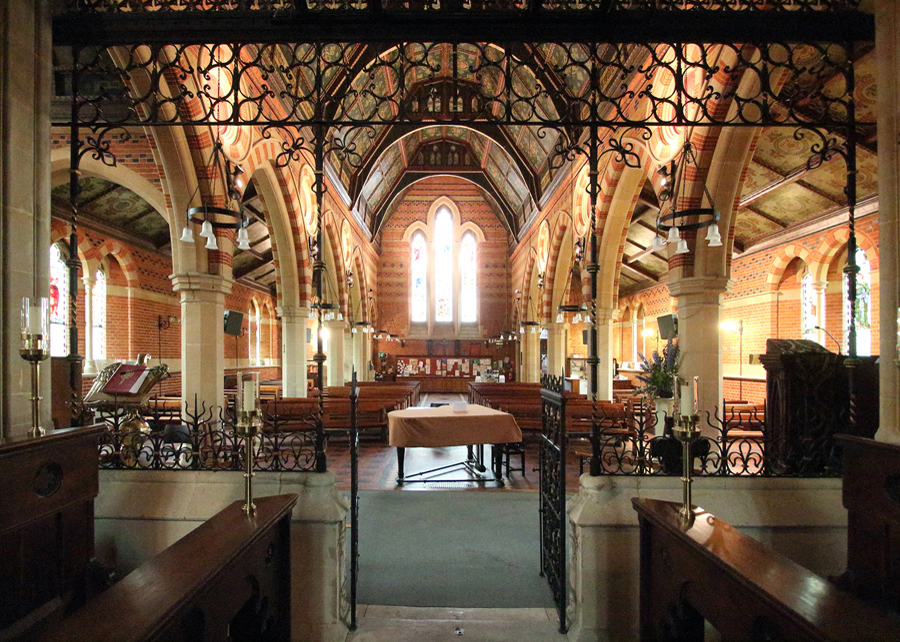You may use the images without prior permission for any scholarly or educational purpose as long as you (1) credit the photographer and (2) link your document to this URL in a web document or to the Victorian Web in a print document. [Click on the images to enlarge them.]

All Saints', on Lower Common, Putney, is in London SW15. It is a Grade II* listed building, designed by G.E. Street and completed in 1874. It is not particularly remarkable on the outside. In fact Arthur Mee described it in the early twentieth century as "a modest-looking church with a little turret on the roof" (782).The listing text describes the exterior and plan in only a little more detail: "Early English style with nave, aisles and transepts in yellow stocks with stone dressings, tile and slate roofs with ridge turret."


Left: Nave looking east. Right: Nave looking west.
The interior however starts to explain its high listing. Here, red brick is patterned with black brick, and the piers of the four bays support banded stone and brick arches. The effect is quite dramatic, and reminiscent of William Butterfield, for whose All Saints, Margaret Street, Street had a long and "deep attachment" (qtd. in Street 48).



Left to right: (a) Choir wagon roof, with colourful stencilled decoration. (b) Nave wagon roof, also painted. (c) Pulpit, with a peep into the choir and a glimpse of the screen.


Left: High altar, with reredos decorated by John Rodham Spencer Stanhope. Right: The chancel screen, with the organ on the left and the lectern on the right.
The fittings would have been designed by Street himself. The screen and lectern are likely to have been executed by Thomas Potter & Sons, often used by Street — their works were nearby at Putney Bridge Wharf. As for the screen, the central part of the reredos represents the last book of the Bible, showing the angel appearing to John, and pointing to the New Jerusalem. On the left are the archangels Uriel, carrying a representation of the sun, St. Michael, holding the scales on which human souls are to be weighed; on the right are Raphael, with his means of healing, and on the far right the Angel Gabriel, holding the lily of the Annunciation. John Rodham Spencer Stanhope, the artist, was closely associated with the Pre-Raphaelites, and was particularly close to Edward Burne-Jones. The postures of the figures on the reredos suggest this association.
Nothing could be more appropriate: attractive as the fabric and decorative elements are, the main glory of the church is in its stained glass by Morris and Co., mostly designed by Burne-Jones. The listing text deems it to be of "outstanding quality" and ends by saying bluntly, "Graded II* for its glass."
Links to related material
- Stained glass windows designed by Sir Edward Burne-Jones and executed by Morris & Co.
- Stained glass windows depicting angels designed by William Morris, and executed by Morris & Co.
- John Rodham Spencer Stanhope and the Pre-Raphaelites
- Stanhope's more elaborate reredos, which used to be in Benjamin Ferrey's Christ Church, Esher (scroll down to see)
Bibliography
Cherry, Bridget, and Nikolaus Pevsner. London 2: South. New Haven and London: Yale University Press, 2002.
Church of All Saints, Lower Common, Putney SW15. Historic England. Web. 1 June 2022.
Mee, Arthur. The King's England: London. London: Hodder and Stoughton, 1937.
Street, Arthur Edmund. Memoir of George Edmund Street RA, 1824-1881. London: John Murray, 1888. Internet Archive. Contributed by the Getty Research Institute. Web. 1 June 2022.
"T. Potter & Co." in "Architects & Artists P-Q." Sussex Parish Churches. Web. 1 June 2022.
Created 1 June 2022